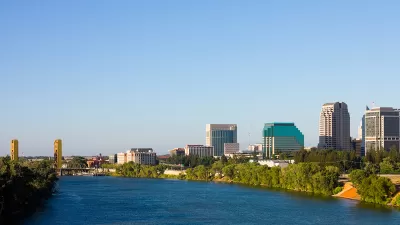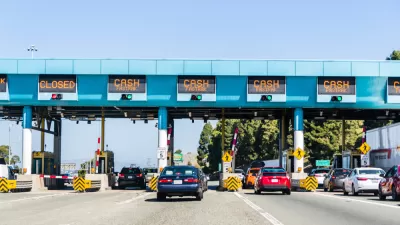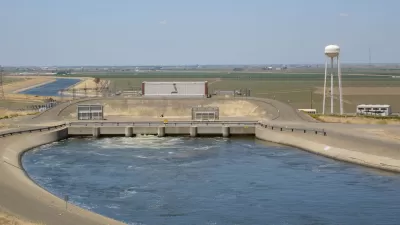California voters in November will have the opportunity to help repair the Friant-Kern Canal, damaged by subsidence, as well as invest in watershed conservation programs, by passing a citizen-initiated $8.9 billion general obligation bond measure.

The Golden State has a subsidence problem, nowhere worse than in the San Joaquin Valley, “the food basket of the world,” due to a five-year drought, unregulated groundwater drilling, and a history of poor water management.
"Subsidence occurs when water is removed from underground aquifers and the surrounding soil collapses on itself," wrote Joseph Serna for the Los Angeles Times in February 2017 about the Valley's sinking problem. "Even if the underground water is replenished, subsided basins can't hold as much water as they did previously."
While landmark legislation passed in 2014 to regulate drilling and the rains returned two years later, four counties were omitted from the governor's declaration ending the drought in April 2017: Fresno, Kings, Tulare and Tuolumne.
Furthermore, the Sustainable Groundwater Management Act, which requires farmers to rein in their pumping, doesn’t fully kick in until 2040, report Phillip Reese and Dale Kasler for The Sacramento Bee on July 13.
One means to repair the aquifer damage will be fixing the Friant-Kern Canal, part of the Central Valley Project completed in 1951 by the United States Bureau of Reclamation, a federal agency under the U.S. Department of the Interior, which transports irrigation and potable water along a 152-mile aqueduct from the "Friant Dam of Millerton Lake, a reservoir on the San Joaquin River north of Fresno, and flows south along the eastern edge of the San Joaquin Valley, ending at the Kern River near Bakersfield," according to Wikipedia. The Friant Water Authority operates the canal for the Burea of Reclamation.
"The canal is sinking as the Valley floor beneath it slowly caves in, brought down by years of groundwater extraction by the region’s farmers," explain Reese and Kasler. "Because farmers use some of the water from the canal to replenish groundwater, fixing the Friant-Kern would help coax the aquifers back to health."
The reporters go on to describe the reliance of farmers on groundwater and the resulting damage to the canal caused by Valley subsidence. "Overall, Valley farmers removed enough groundwater during the drought to fill Shasta Lake seven times over, according to a study last year by researchers at UCLA and the University of Houston."
At a point 100 miles south of the dam, just west of the tiny community of Terra Bella, [Tulare County] the canal dropped about 2 feet between 2015 and 2017. That created a choke point that has left canal operators unable to deliver 60 percent of the water to farms and cities along the last 50 miles or so of the canal’s low spot.
The canal has lost half of its capacity, and will cost $350 million to fix.
Enter Proposition 3, Water Infrastructure and Watershed Conservation Bond Initiative, an initiated state statute that California voters will decide on November 6, 2018. The measure is sponsored by the Californians for Safe Drinking Water and a Clean and Reliable Water Supply.
If voters approve Proposition 3 in November, the state would borrow $8.9 billion for various water projects, including $750 million to improve conservation and groundwater-recharge efforts in the Friant area. That sum would include an estimated $350 million to repair the Friant-Kern and a smaller canal, also operated by the Friant Authority, that suffers from subsidence.
Opposition
According to Kasler and Reese, the measure has no organized opposition as of July 13, though Sierra Club California did issue a 6-point opposition paper [pdf]. Their third point addresses the funds directed to the Friant-Kern Canal and the Friant area.
This $750 million in subsidies could—and likely will—help the Friant Water Authority fund dam projects that are harmful to the environment and strongly opposed by the environmental community. The Friant-Kern Canals are units of the Federal Central Valley Project, which is funded almost entirely by 20 [sic] agricultural water agencies which collectively irrigate 879,000 acres of farmland.
Purported needs for additional funding cite increased groundwater pumping that has led to subsidence, which has damaged the canals. Those who pumped the water and caused the damage should pay to repair the canals...
"Why shouldn’t Friant farmers pay for [the canal repairs]? ask Kasler and Reese. "Didn’t they cause the problem by pumping groundwater?"
Not exactly. Jerry Meral [a prominent environmentalist, former deputy secretary of the California Natural Resources Agency, and chief promoter of the initiative] and independent experts say Friant’s farmers are only partly to blame. Much of the subsidence has been caused by farmers just outside Friant’s territory, they say.
If Proposition 3 fails in November, the funding question goes back to square one. Jason Phillips, the Friant Authority’s chief executive, said hundreds of thousands of acres of farmland would risk going out of production if their water supply remains constricted.
Last month, state voters approved Proposition 68, a $4 billion, a legislatively-referred general obligation bond act, by nearly 58 percent. It included funds for water infrastructure, flood protection, and parks.
Related reading
- For a quicker read on the measure's pros and cons, see Dan Morain's blog in CALmatters on July 16.
If voters approve Proposition 3, the $8.9 billion water bond on the November ballot, taxpayers would pay $17.3 billion during the bond’s 40-year life, the Legislative Analyst’s office says.
-
Jerry Meral, Prop 3 proponent, was interviewed by The Planning Report (via Planetizen) in May about the initiative.
-
News of subsidence in Lindsay, Tulare County, near the Friant-Kern Canal, was posted last December.
-
The dateline for a feature New York Times article about how the drought was hurting California agriculture, written by Justin Gillis in the drought's fourth year in December 2015, was Friant.
“We are living with a legacy of decades of overallocating our water, and refusing to say ‘no’ when people want more,” said Doug Obegi, a lawyer with the Natural Resources Defense Council in San Francisco. “When people think they are entitled to more water than exists in the system, that’s a recipe for failure.”
FULL STORY: The Valley floor is sinking, and it’s crippling California’s ability to deliver water

Planetizen Federal Action Tracker
A weekly monitor of how Trump’s orders and actions are impacting planners and planning in America.

Maui's Vacation Rental Debate Turns Ugly
Verbal attacks, misinformation campaigns and fistfights plague a high-stakes debate to convert thousands of vacation rentals into long-term housing.

San Francisco Suspends Traffic Calming Amidst Record Deaths
Citing “a challenging fiscal landscape,” the city will cease the program on the heels of 42 traffic deaths, including 24 pedestrians.

Amtrak Rolls Out New Orleans to Alabama “Mardi Gras” Train
The new service will operate morning and evening departures between Mobile and New Orleans.

The Subversive Car-Free Guide to Trump's Great American Road Trip
Car-free ways to access Chicagoland’s best tourist attractions.

San Antonio and Austin are Fusing Into one Massive Megaregion
The region spanning the two central Texas cities is growing fast, posing challenges for local infrastructure and water supplies.
Urban Design for Planners 1: Software Tools
This six-course series explores essential urban design concepts using open source software and equips planners with the tools they need to participate fully in the urban design process.
Planning for Universal Design
Learn the tools for implementing Universal Design in planning regulations.
Heyer Gruel & Associates PA
JM Goldson LLC
Custer County Colorado
City of Camden Redevelopment Agency
City of Astoria
Transportation Research & Education Center (TREC) at Portland State University
Jefferson Parish Government
Camden Redevelopment Agency
City of Claremont





























